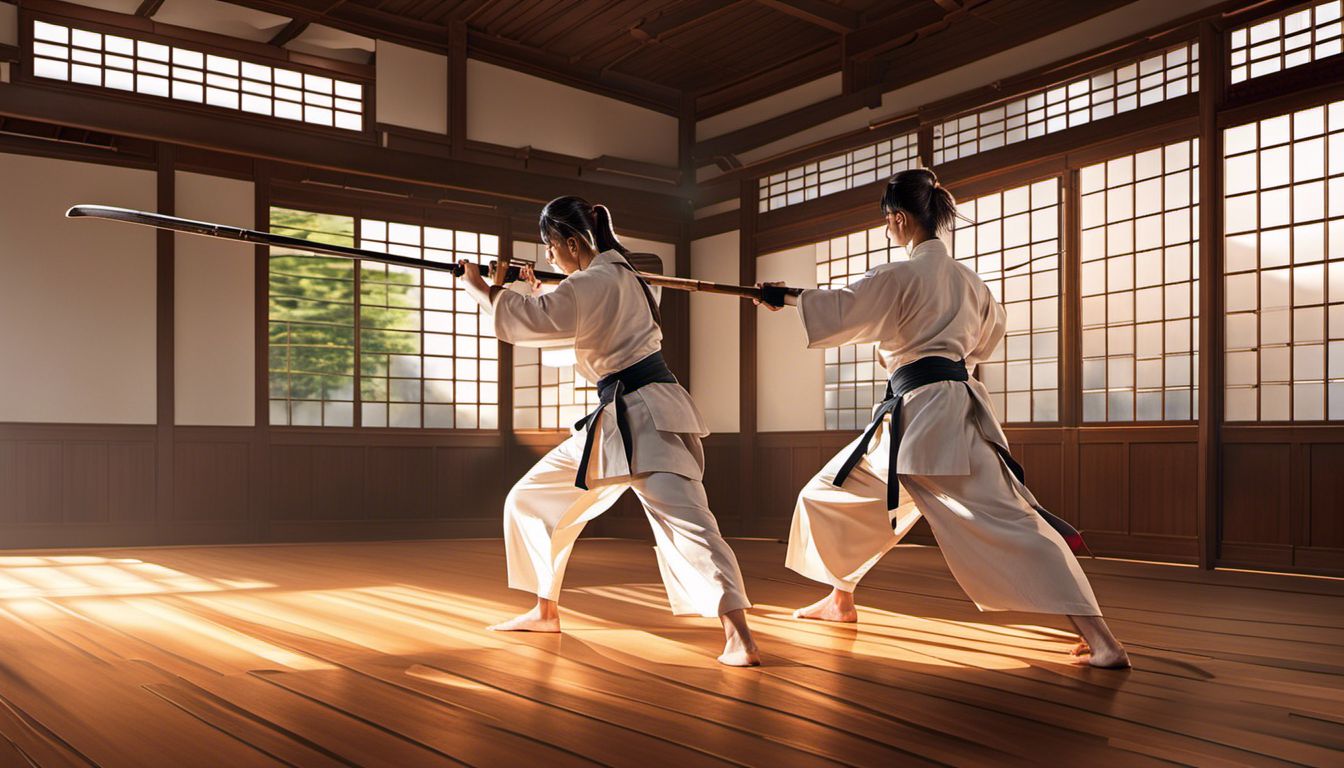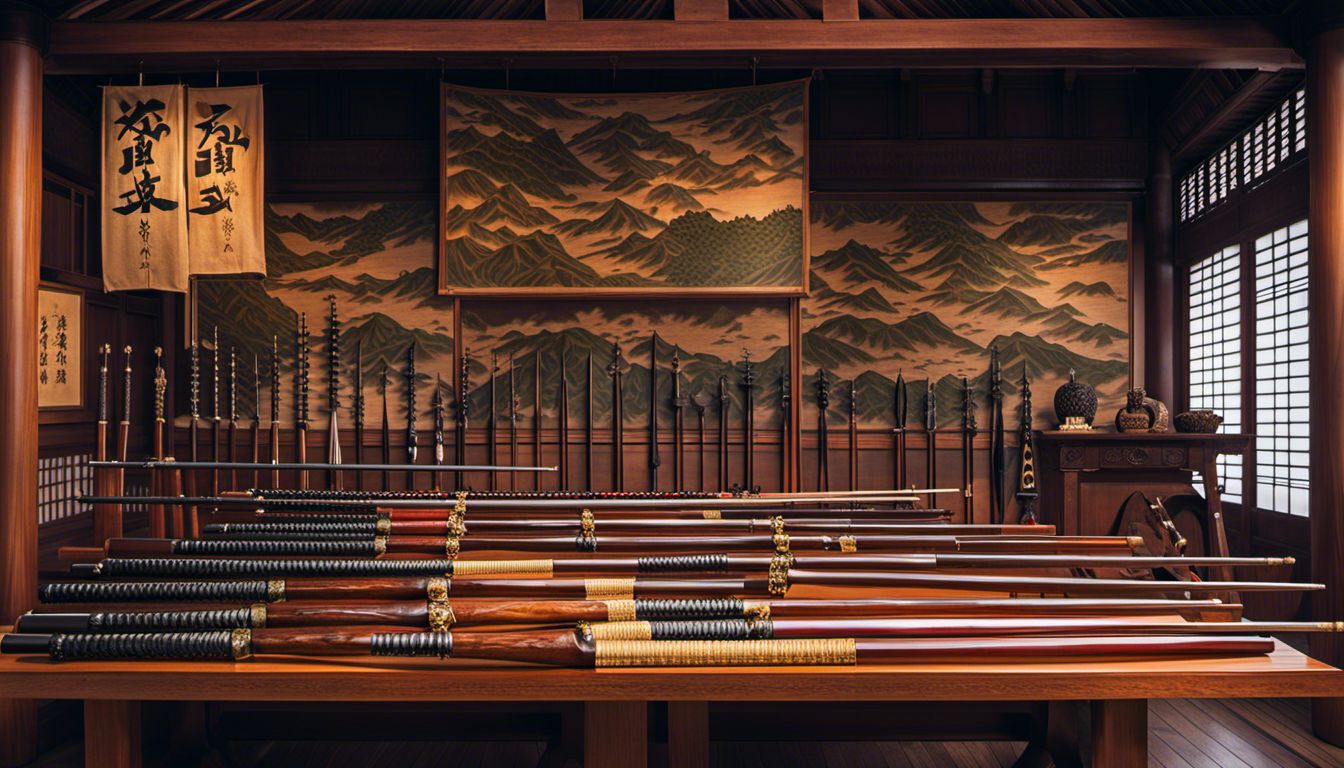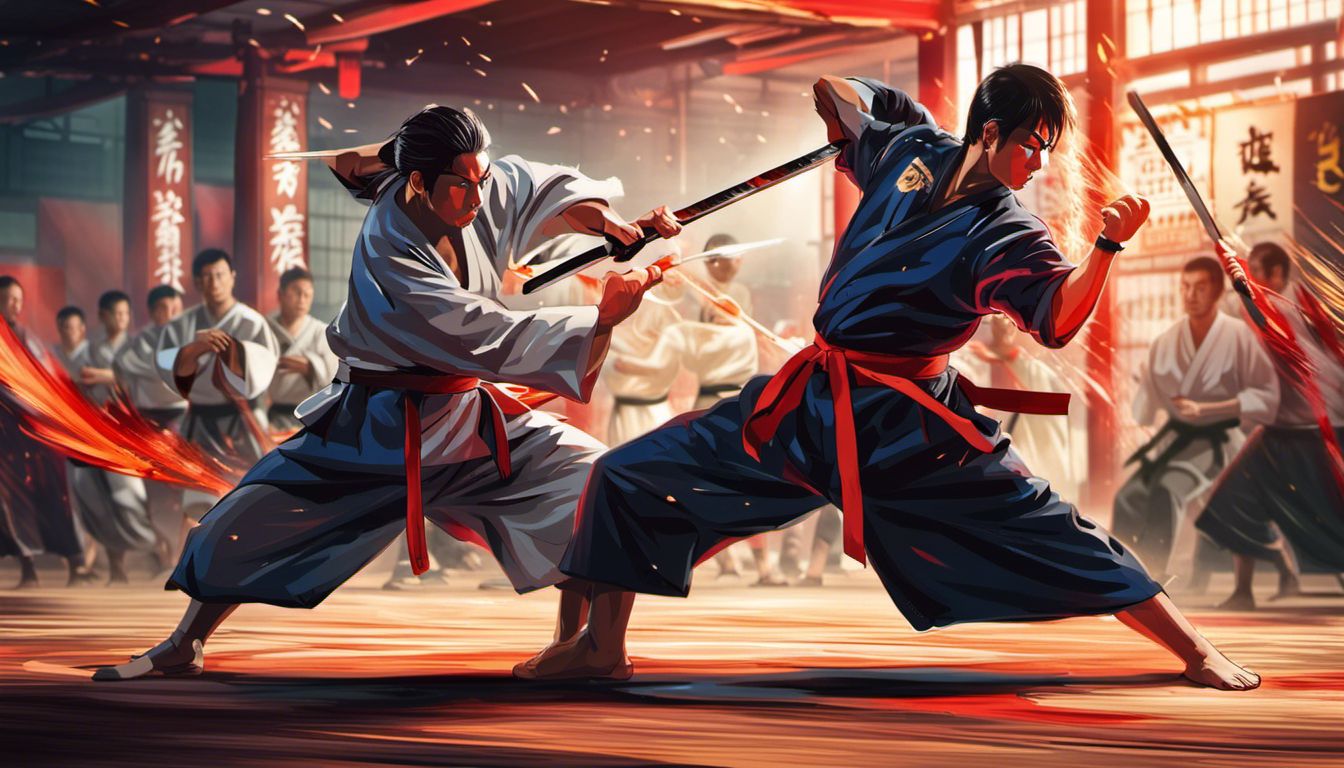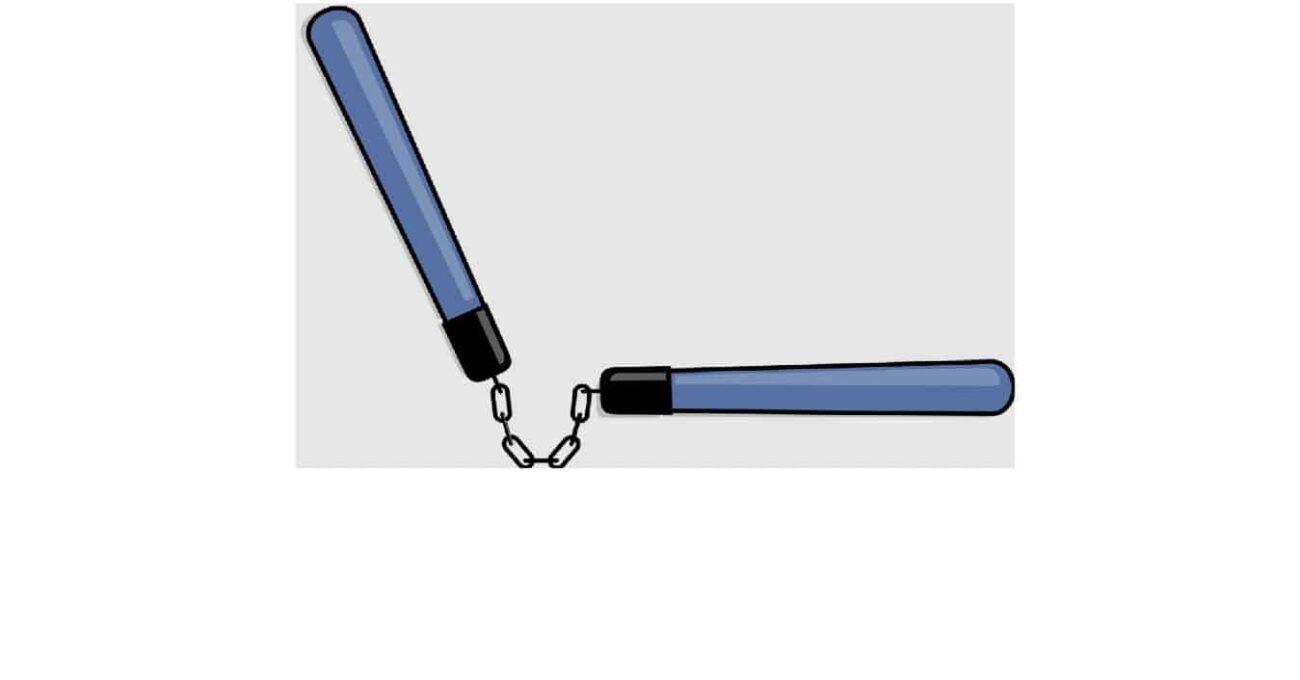In this article, I will dive into what Kobudo is, what it means, and where it comes from, and ultimately answer the question: what is Kobudo?
Kobudo is a traditional Okinawan weapon martial art, which probably developed somewhere between the 17th and 19th century, by mostly farmers to defend themselves against Satsuma samurai.
There are some other versions of its history, but this is the most widely known theory.
Kobudo is a complex martial art that deals with a lot of weapons, like the Sai, Bo, Kama, and a lot of others.
Read on to find out more about this forgotten martial art and its teachings!
Kobudo Meaning
I will shortly touch on the origin and the meaning of Kobudo before I start exploring the art itself.
When translated, it can mean “old martial way of Okinawa”, though literally it only means something along the lines of “old martial art”.
It is considered to be like a sibling to karate, since both have been developed in Okinawa, and they go hand-in-hand due to the fact that one is traditionally an empty hand art (that is what the karate word is usually translated to), while the other is exclusively a weapon art.
Some martial arts historians even believe that Kobudo was the forerunner of karate and that it served in many ways as the inspiration for numerous techniques.
What Is Kobudo?
So now that I have covered some basic origins and meaning, we can look into what it actually is.
As I have mentioned, it is a weapon-based martial art from Okinawa. It isn’t very famous in the modern world, for reasons I will later look into.
The main weapons Kobudo deals with are Bo, Sai, Kama, Tonfa, Nunchaku, Tenko, Tinbe-Rochin, Surujin, Tambo, and some others.
Aside from the fact that it is a weapon martial art in the first place, the variety of weapons also makes it a very interesting and also hard-to-learn art.
There are many varieties to the art, all of which deal with different types of weapons, but there are a couple of forms of it that require the mastery of all weapons I listed and more in order for one to master it.
Origins and Etymology of Kobudo

The roots of Kobudo lie deep in the Ryukyu Kingdom, presently known as Okinawa, Japan. It emerged as a comprehensive fighting methodology among the Pechin warrior caste during a time when weapons were restricted by ruling samurai clans.
The term ‘Kobudo’ finds its origin from two Japanese words: Ko (old), and Budō (the way of war). This direct translation signifies an “old martial way.”.
In essence, Kobudo is indeed old; however, it’s continually evolving and adapting to modern requirements while maintaining traditional values. Its terminology has been influenced heavily by various factors throughout history including political changes and cultural interactions with neighboring countries like China.
That’s why each weapon in Kobudo bears a unique name derived from either its appearance or functionality such as bō (staff) or sai (trident).
History of Kobudo

Kobudo sprouted roots on the Ryukyu Islands, now known as Okinawa, during a time of political unrest and conflict. The Pechin warrior caste wielded these weapons to serve the Ryukyuan king, while commoners or “Heimin” used them to protect themselves from adversaries.
Many other Chinese martial arts techniques also heavily influenced Kobudo during this period.
The Meiji Restoration marked a turning point for Kobudo development when Japan proposed bans on traditional weaponry in an attempt to modernize warfare. Despite this adversity, Okinawan practitioners kept their traditions alive by discreetly adapting farming tools into alternative weapons – a feat that encapsulates true martial art spirit.
In more recent history, Kobudo has been elemental in shaping Karate systems all over the globe. Renowned masters such as Taira Shinken and Kenwa Mabuni have played significant roles in its promotion and preservation since World War II.”.
Techniques and Weapons in Kobudo
Discover the ancient art of Kobudo and unveil the secrets of Okinawan weaponry. From the staff to the nunchaku, explore the rich history, weapons training and techniques that make up this unique martial art.
Are you ready to uncover the hidden power within these traditional weapons? Read more for an exciting journey into Kobudo.Kobudo Weapons List
I listed the weapons used, and now we will take a closer look at the weapons which can be found in all variations of Kobudo.
Kobudo Weapons List

I listed the weapons used, and now we will take a closer look at the weapons which can be found in all variations of Kobudo.
Bō: The Staff

The absolute most widely used weapon in Kobudo, the Bo staff is a long and straight wooden staff, usually around 6 feet long, but can reach lengths of up to 9 feet.
The versatility of this weapon, aside from the fact that it is very easy to make and cheap to buy, is what makes it so popular.
There is no Kobudo form or style which doesn’t at some point contain techniques with the Bo staff.
It was also very effective, since unlike a katana, which only had one attacking side and could break if edge alignment wasn’t executed properly, the Bo staff, like any staff, could be used from all angles and directions.
Both ends, sometimes even the middle of the staff is used to strike, even more so to lock weapons, block them, or to throw the opponent to the ground.
Sai: The Trident

Probably the most iconic one of these weapons (in the Japanese context), the Sai is a three-pronged weapon, with one long center prong and two side-prongs which all come from the handle of the weapon, which is also known as the tsuka.
The weapon can be used for quick thrusting and highly effective defense as well, and the small size and weight of the weapon make it feel like an extension to the arm of its wielder.
The Sai should be as long as to extend between 1-3 inches from your elbow while measuring it to your forearm and hand, making the average Sai size around 20 inches.
There are way longer and way shorter variations, however.
Tonfa: The Baton

The Tonfa also sometimes spelled as Tonfa, also known as T-baton in modern language is a close-range, technical melee weapon best known for its role in the armed component of Okinawan martial arts (or in other words, Kobudo) and its modern use in many police forces worldwide.
It consists of a relatively short stick with a perpendicular handle attached at around a third of the way down the length of the stick and is about 15–20 inches long.
It was traditionally made from red or white oak and wielded in pairs, even though policemen nowadays only wield one.
The tonfa is believed to have originated in either China or Southeast Asia where.
It is highly technical and effective, since it acts as an armor to one’s arm in some sense, making blocking strikes very easy and sometimes painful for the opponent, and also rendering punches and strikes exponentially stronger than a simple fist punch.
Aside from striking and blocking, the Tonfa can be very effectively be used for engaging in close-quarters combat, since they can provide leverage to subdue an opponent easily.
The pressure Tonfas can put on bones in close-range combat is more than enough to break bones if necessary.
Nunchaku: The Flail

The reason I wrote that Sais are the most iconic in a Japanese context is that Nunchaku are definitely the most iconic ones in a general Eastern martial arts context.
However, it is a common misconception that Nunchaku are Chinese, they in fact originate from Okinawa, the home of Karate and Kobudo amongst other martial arts-related things.
The Nunchaku probably was first a flail used to thresh rice, then it was turned into a weapon.
One of the main advantages of Nunchaku over other weapons is that it is relatively small, insanely fast, and very powerful.
You don’t even need a strong strike, just a moderate blow can easily break a skull or shatter a collar bone.
Martial artists who have mastered the Nunchaku are formidable enemies since the Nunchaku can also be used to grab the enemies’ weapon and twist it out of their hands or to block with extreme speed.
It is present in most, if not all Kobudo styles as well.
Kama: The Sickle

The last Kobudo weapon I will talk about is the Kama.
Kama means sickle, and there is really not much creativity and imagination required for someone to see where this comes from.
The shape and size are virtually the same as any farmer’s sickle since they realized that no modification is needed to a sickle to make it a dangerous weapon.
It gave rise to a couple of different weapons like the Kusarigama, which is basically the Kama attached to a string, which is also a very intimidating weapon and one used in Kobudo.
The Kama’s L-shape makes the motion and the trajectory of the moving blade really hard to intuitively have a grasp on.
For example, a medieval longsword was simple and straight, and one knew that they just have to stay away from it.
However, the Kama doesn’t give you the option of being slightly cut if the weapon grazes you; if the Kama’s blade touches you, you are most likely going to die.
This is because if you look at the blade of a Kama in an extended arm, all the power of the blade will be concentrated at the very tip, where the whole blade lies.
This makes the Kama all the more vicious of a weapon.
Kamas can also be really fast, which combined with the blade angle make it a very effective weapon.
Eku: The Oar
The eku is a unique weapon used in Okinawan Kobudo. It resembles an oar and has a slight point at the tip, along with a curved paddle. This design makes it stand out among other weapons in the martial art.
The eku is believed to have originated from a farming tool called a tenbin. With its distinct shape and versatility, the eku is highly valued by practitioners of Okinawan Kobudo.
Tinbe-rochin: The Shield and Short Spear
The tinbe-rochin is a versatile weapon in Okinawan Kobudo, combining both a shield and a short spear. The shield, made from materials such as vine, cane, or even turtle shell, provides protection while the spear allows for offensive strikes.
This weapon is an integral part of the techniques and weapons used in Okinawan Kobudo, which encompasses various other weapons like the bō, sai, tonfa, kama, nunchaku, and eku. In self-defense situations or combat scenarios, the tinbe-rochin can be effectively combined with other weapons to create powerful and efficient fighting combinations.
Sansetsukon: The Three Section Staff
The sansetsukon is an intriguing weapon that holds a prominent place in the world of Kobudo. It consists of three sections of wood connected by a cord or chain, resembling a nunchaku but with an added element.
This unique weapon requires precise body control and mastery of movement to wield effectively. While it shares similarities with other weapons like the nunchaku and tonfa, the sansetsukon has its own distinct techniques and applications.
Due to its complexity, learning the techniques of the sansetsukon demands dedication, and extensive practice, making it one of the more challenging weapons to master in Kobudo.
Nunti: The Trident Spear
The Nunti is a unique and distinctive weapon in Okinawan Kobudo, the traditional martial art of Okinawa. It features a manji-shaped sai mounted on the end, creating a trident spear.
Like other weapons in Kobudo, mastering the Nunti requires specific techniques and skills. This versatile weapon can be used for striking, blocking, and trapping techniques, making it an essential part of any Kobudo practitioner’s arsenal.
With its rich history and practical applications, the Nunti serves as a testament to the ingenuity and effectiveness of Okinawan weaponry.
Kuwa: The Hoe
The kuwa, a hoe commonly used as a farming tool, is also an essential weapon in Okinawan Kobudo. This versatile and effective weapon requires unique techniques and skills to wield effectively.
With its origins rooted in its use as a farming tool, the kuwa showcases the practicality that defines Okinawan Kobudo.
Tekko: The Iron Fist
Tekko, also known as the Iron Fist, is a unique weapon that plays a significant role in Okinawan Kobudo. It is a form of knuckleduster primarily used in empty-hand techniques. Tekko is one of the many weapons included in the curriculum of Okinawan martial arts.
Used for striking and blocking, this weapon provides an added level of protection to the practitioner’s hands while delivering powerful blows. With its rich history and practicality, Tekko remains an essential part of Okinawan Kobudo and continues to be studied and practiced by martial arts enthusiasts worldwide.
Yari: The Spear
The yari is a powerful and versatile weapon often used in Okinawan Kobudo. With its long history dating back to ancient times, this spear was wielded by skilled warriors who relied on its effectiveness for self-defense.
The techniques associated with the yari require precision and skill, making it an essential weapon in the practice of Kobudo. With its sharp point and sturdy shaft, the yari allows for both thrusting and cutting techniques, making it a formidable tool in combat situations.
Martial arts enthusiasts can appreciate the artistry and discipline required to master this iconic weapon from Okinawa’s rich martial heritage.
Surujin: The Weighted Chain
The surujin is an intriguing weapon used in Okinawan Kobudo. This weighted chain or leather cord can be easily concealed, making it a covert and versatile tool for combat. While not as well-known as other weapons in the art of Kobudo, the history and techniques of the surujin are fascinating to explore.
Mastering this weapon requires great skill and control, allowing practitioners to wield its power effectively in battle.
Nunti Bo: The Trident Staff
The Nunti Bo is a trident staff used in Kobudo, the ancient martial art of Okinawa, Japan. It is a unique weapon that resembles a spear with a manji-shaped sai attached to the end.
This makes it stand out from other staff weapons like the Bō. The Nunti Bo plays an essential role in Okinawan Kobudo and requires specific techniques and skills to master. With its origins rooted in Okinawa, this trident staff has become an integral part of traditional martial arts in Japan and continues to be practiced and respected by enthusiasts around the world.
Frequantly Asked Questions About Kobudo
Q: What is Okinawan Kobudo and its significance in traditional martial arts?
A: Okinawan Kobudo refers to a traditional martial arts system from Okinawa, the birthplace of Karate. It is a complete martial art that emphasizes the study of weapons alongside empty hand techniques. Kobudo not only enhances one’s Karate skills but also contributes to the overall development of a martial artist. The practice of Kobudo brings balance and harmony to one’s art like no other.
Q: How can one learn Kobudo and begin weapons training?
A: To learn Kobudo, it is important to find a qualified Sensei who can guide you through this intricate martial art. Kobudo training includes learning a variety of weapons techniques, mastering different katas, and frequently practicing with a partner. You would also need to acquire Kobudo equipment for your practice. But most importantly, continuous dedication and practice is mandatory to learn Kobudo.
Q: Can you describe some of the traditional Kobudo weapons?
A: Yes, there are several traditional Kobudo weapons. The ‘Bo’ is a long staff, traditionally used by Okinawans as a walking stick or to carry goods. The ‘Nunchaku’ is another key weapon in Kobudo, known worldwide due to its popularisation by Bruce Lee. Other weapons include the ‘Sai’, ‘Kama’, ‘Tonfa’, and ‘Tekko’. Each weapon has its unique stances and techniques that form part of the Kobudo fighting system.
Q: What is the role of Katas in Okinawan Kobudo?
A: Katas in Okinawan Kobudo and Karate form a vital part of the training regimen. These are pre-arranged fighting techniques or sequences practiced as a form of training and performance. Kobudo kata often incorporate a lot of weapons movements to simulate fighting multiple opponents. It aids in the mastery of both empty hand techniques and weapon handling.
Q: What distinguishes Okinawan Karate from Okinawan Kobudo?
A: Okinawan Karate primarily focuses on mastering stances, punches, kicks and other empty hand techniques, while Okinawan Kobudo complements it by extending its focus on weapon-based techniques. While the two are distinct, they are often practiced in conjunction, and many traditional dojos consider Kobudo an integral part of Okinawan Karate.
Q: Why did Okinawans use common tools like the broom and sickle as weapons?
A: The usage of such implements as weapons in Kobudo came into existence due to a variety of reasons, including laws forbidding the carrying of weapons and a short supply of traditional weapons. Again, tools like brooms (used as Bo) and sickles (as Kama) are easily accessible implements incorporated into the fighting techniques of Kobudo.
Q: What is Eiku and how is it used in Okinawan Kobudo?
A: The Eiku (or Eku) is a Kobudo weapon traditionally used by Okinawans for rowing their boats. In Kobudo, however, it is wielded much like a sword and is frequently used in Kata practice. Its techniques are unique, involving both the blade and the non-bladed side for offensive and defensive maneuvers.
Q: Is practicing with a partner important in Kobudo training?
A: Yes, practicing Kobudo with a partner is important, especially when learning new Kata or Kumite (sparring). It allows for practicing timing and understanding the practical applications of the techniques. Moreover, practicing with a partner helps develop greater understanding and control over the various Kobudo weapons.
Q: Do I need previous experience in Karate before starting Kobudo training?
A: While having a background in Karate can be beneficial, it is not a prerequisite for learning Kobudo. Kobudo like Karate, is suitable for everybody, regardless of age or fitness level. It encompasses a wide range of techniques, practices, and weapons that can be learnt from scratch under the supervision of a knowledgeable Sensei.
Q: How is the training in a traditional Kobudo dojo conducted?
A: Traditional Kobudo training typically begins with warm-up exercises, followed by basic techniques practice, i.e., punches, kicks, moves, footing, and weapon handling. This is then followed by Kata and Kumite. The training is designed to be comprehensive, covering various weapons techniques and their applications. Periodic grading systems are also there to assess the progression levels of Kobudo practitioners.
Q: What is Okinawan Kobudo and why is it referred to as the birthplace of karate?
A: Kobudo is an ancient martial art that originated from Okinawa, an island in Japan. It is referred to as the birthplace of karate because it’s where the practice of karate was first developed. Okinawan Kobudo involves the use of traditional Okinawan weapons such as bo, nunchaku, sai, kama, tonfa, tekko, and the foot staff, in kata, a pattern of movements and techniques that is also a core part of karate.
Q: How can I start practicing Okinawan Kobudo?
A: Kobudo training can be started by enlisting in a local martial arts dojo that offers kobudo practice, or by taking an online course offered by recognized kobudo practitioners such as Nakamoto Masahiro or Jesse Enkamp. Keep in mind that practice weapons are utilized in the beginning stages to minimize the risk of injury.
Q: What is bo in Kobudo practice?
A: Bo refers to a foot staff, a common weapon in Kobudo practice. It is a long wooden staff used to teach students balance and stance, preparing them for the use of other weapons in the future. This weapon is frequently used in karate as well. The bo is also used in pairs during some techniques.
Q: Can kobudo be used for self-defense?
A: Yes, the skills and techniques learned in kobudo training can be utilized in real-life situations for self-defense. This martial art was in fact developed by farmers and fishers in Okinawa who were banned from carrying weapons by the authorities. They turned everyday farming tools into weapons for self-defense, thus Okinawan Kobudo evolved. Nevertheless, mastery of kobudo requires rigorous and disciplined training.
Q: What are the sai and nunchaku used in Okinawan Kobudo?
A: Sai and nunchaku are two traditional Okinawan weapons used in kobudo. The sai is a traditional Okinawan weapon that is typically used in pairs. It is a dagger-shaped truncheon that has two sharp edges and was originally used for stabbing in close combat. The nunchaku consists of two sections of wood connected by a short chain or rope. The length of the chain can vary.
Q: How does karate kata relate to kobudo practice?
A: Kata is a Japanese term referring to a pattern of movements used in martial arts. In kobudo practice, kata involves a sequence of weapon techniques designed for either defense or attack. This form of tutorial is essential in training kobudo as it allows the practitioner to understand the motion of the weapon, build agility, and perfect control. Hence, kata is equally important in both, karate and kobudo practice.
Q: I am a karate black belt, can I take up Kobudo?
A: Yes, definitely. Being a black belt in karate provides a solid foundation for learning Kobudo. Many kobudo skills and techniques are transferable as both martial arts forms originated from the same place – Okinawa. Furthermore, both forms incorporate the use of kata (sequence of movements) in their training, which will be an advantage for karate black belt holders in kobudo training.
Q: Who are some famous Kobudo masters I can learn from?
A: There are many prominent Kobudo masters around the world. Yabiku Moden and Nakamoto Masahiro are among the notable figures renowned for their contribution to the preservation and promotion of this ancient martial art. You can also learn from Jesse Enkamp who offers online Kobudo training programs.
Q: What are the health benefits of practicing Okinawan Kobudo?
A: Practicing Kobudo helps in physical conditioning and strengthening, providing an overall combative physical fitness. Improved coordination, balance, agility, and reflexes are some of the other benefits of actively engaging in Kobudo. Moreover, it also aids in mental and emotional well being, enhancement of concentration, and stress relief.
Q: How does Kobudo differ from Kendo?
A: While both are forms of Japanese martial arts, they have distinct differences. Kobudo originated in Okinawa and focuses on the use of traditional weapons such as bo, nunchaku, sai, and more. On the other hand, Kendo, which originated in mainland Japan, emphasizes sword fighting techniques using bamboo swords. Both martial art forms require discipline and respect, but the techniques, weapons, and historical context differ.

